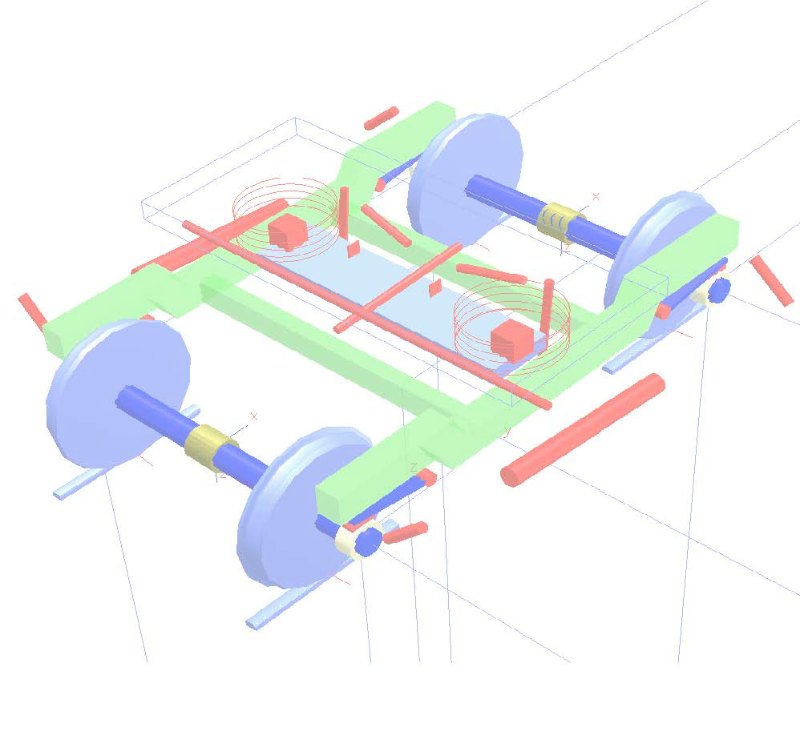Rail vehicle dynamics and interaction between vehicle and track. The track and the vehicle (in brief). Fundamentals of vehicle-track interaction. Some simple vehicle models and pertinent equations of motion. Eigenvalue analysis, transfer functions and other types of analysis. Models of wheelsets, bogie frames and car bodies. Geometry and guidance for wheelset and track. Creep (sliding), creep forces (friction forces), ride stability and curve negotiation. Track forces. Safety against derailment: wheel flange climbing, vehicle turnover, rail turnover. Wheel and rail wear. Ride comfort. Vehicle gauging. Examples on different vehicles' dynamic interaction with the track. Simulation and measurement in practise. Exercises. Assignments. Project task (computer work): simulation of dynamic interaction between rail vehicle and track. Study visit.
SD2313 Rail Vehicle Dynamics 8.0 credits

This course deals with vehicle dynamics for rail vehicles, incl. interaction with the track. The topic has become increasingly important due to the need for faster and heavier trains.
Information per course offering
Choose semester and course offering to see current information and more about the course, such as course syllabus, study period, and application information.
Course syllabus as PDF
Please note: all information from the Course syllabus is available on this page in an accessible format.
Course syllabus SD2313 (Autumn 2013–)Content and learning outcomes
Course contents
Intended learning outcomes
The overall aim of the course is to become prepared to work as vehicle dynamics engineer in industry or for railway operators/authorities. You shall be familiar to the different problems involved in dynamic vehicle-track interaction and be capable of actively choosing system properties that result in good vehicle performance and limited damage to vehicle and track components.
More specifically this means that after a fulfilled course you should be able to:
- list the vehicle and track components that influence the dynamic system behaviour and also how
- use derived equations to calculate permissible speed or nominal track geometry needed
- explain mathematically why and when vehicle ride instability can occur
- derive the equations for wheel-rail forces for vehicles at quasistatic curving
- discuss the trade-off between stability and curving performance, and its practical implications
- explain how wheel and rail profiles, and equivalent conicity, affect the trade-off above
- describe how wheel and rail wear can be predicted and how it can be reduced
- describe how ride comfort in rail vehicles is evaluated and reflect on how the comfort can be improved
- use MATLAB and multibody dynamics softwares to practise most of the aspects in the course
Literature and preparations
Specific prerequisites
150 university credits (hp) in engineering and documented proficiency in English corresponding to English B/ English 6.
Literature
Andersson E, Berg M and Stichel S: Rail Vehicle Dynamics, kompendium (på engelska), Avd. för Spårfordon, KTH, Stockholm.
Examination and completion
Grading scale
Examination
- PRO1 - Project, 2.0 credits, grading scale: P, F
- ÖVN1 - Assignments, 2.0 credits, grading scale: P, F
- TEN1 - Examination, 4.0 credits, grading scale: P, F
Based on recommendation from KTH’s coordinator for disabilities, the examiner will decide how to adapt an examination for students with documented disability.
The examiner may apply another examination format when re-examining individual students.
If the course is discontinued, students may request to be examined during the following two academic years.
Other requirements for final grade
Written exam (TENA; 4 university credits). Assignments (ÖVNA; 2 university credits). Project task (PRO1; 2 university credits).
Examiner
Ethical approach
- All members of a group are responsible for the group's work.
- In any assessment, every student shall honestly disclose any help received and sources used.
- In an oral assessment, every student shall be able to present and answer questions about the entire assignment and solution.